Experimental and Numerical Investigation into Full-Scale Model of New Type Assembled Integral Utility Tunnel
Abstract
:1. Introduction
2. New Design of Assembled Integral Utility Tunnel
2.1. Project Overview
2.2. Division of Assembled Components
2.3. Structural Design
2.4. Simulation Analysis
3. Full-Scale Model Test
3.1. Full-Scale Model Fabrication
3.2. Test Loading Preparation
3.3. Measurement and Equipment
4. Test Phenomena and Results
4.1. Cracks
4.2. Deformation
4.3. Strain and Internal Force Analysis
4.4. Analysis of Load-Deflection Comparison
5. Discussion and Prospect
- The assembly rate of this prefabricated assembled concrete utility tunnel is relatively higher, with lifting and assembly processes completed on-site. There is less on-site wet cast-in-place work, which can improve construction efficiency and shorten the construction period.
- The components of the prefabricated assembled concrete utility tunnel are relatively small. According to the calculation results of Section 2.2, the heaviest component weighs only 14.2 tons, easily meeting the transportation and lifting requirements during on-site construction.
- The main components of the utility tunnel are produced in standardized industrial factories using assembly line production methods. They are produced according to uniform standards, reducing dimensional errors and ensuring the quality of the components.
- The main structure of the utility tunnel is completed outside the construction site, enabling fast on-site assembly. After partial installation, backfilling and burial can be carried out, reducing the impact on the surrounding environment and the daily life and transportation of citizens.
6. Conclusions
- No cracks were found when the utility tunnel was loaded up to the load standard value. When loaded to the design value, slight cracks appeared along the tenon joints of the side walls. No cracks were observed on the roof slab under the ultimate load.
- As the load increased, the deformation of the composite continuous slab gradually increased. However, the deformation control capability remained within the design requirements, and no significant local damage occurred. When the roof slab was loaded to the design value, the maximum displacement at the mid-span of the large chamber was 1.075 mm. When loaded to the ultimate load, the maximum displacement at the mid-span of the large chamber was 1.465 mm.
- From the strain analysis results, it can be observed that the composite continuous slab underwent plastic deformation after the design load, but its overall load-bearing performance remained good, and no failure occurred. The strain analysis results at the tenon support indicate that the concrete strain changed linearly at various locations. The tenon support exhibited good overall working performance during the loading process and did not experience shear failure.
- Before reaching the standard load value, the strain development at the mid-span section was slow. After reaching the design load, the steel strain developed rapidly, with an average strain increment of 25.55 με. At the final load value, the maximum tensile strain of the steel was 463 με. The load-bearing supports at both ends of the two slabs did not experience shear failure, and the concrete strain changed linearly at various locations.
- Under the ultimate load, the composite continuous slab did not undergo failure and remained in the elastic stage. This indicates that it had a certain amount of load-bearing capacity surplus and the potential for further optimization of the design.
Author Contributions
Funding
Data Availability Statement
Conflicts of Interest
References
- Hunt, D.V.L.; Nash, D.; Rogers, C.D.F. Sustainable utility placement via Multi-Utility tunnel. Tunn. Undergr. Space Technol. 2014, 39, 15–26. [Google Scholar] [CrossRef]
- Canto-Perello, J.; Curiel-Esparza, J. Human factors engineering in utility tunnel design. Tunn. Undergr. Space Technol. 2001, 16, 211–215. [Google Scholar] [CrossRef]
- Cano-Hurtado, J.J.; Canto-Perello, J. Sustainable development of urban underground space for utilities. Tunn. Undergr. Space Technol. 1999, 14, 335–340. [Google Scholar] [CrossRef]
- Ding, X.M.; Zhang, J.C.; Xu, Y.; Zhu, C. Discussion on Construction and Management of the Common Trench in Guangzhou University Town. Chin. J. Undergr. Space Eng. 2010, 6, 1385–1389+1469. [Google Scholar]
- Luo, Y.; Alaghbandrad, A.; Genger, T.K.; Hammad, A. History and recent development of multi-purpose utility tunnel. Tunn. Undergr. Space Technol. 2020, 103, 103511. [Google Scholar] [CrossRef]
- Canto-Perello, J.; Curiel-Esparza, J.; Calvo, V. Criticality and threat analysis on utility tunnel for planning security policies of utilities in urban underground space. Expert Syst. Appl. 2013, 40, 4707–4714. [Google Scholar] [CrossRef]
- Yang, C.; Peng, F.L. Discussion on the development of underground utility tunnel in China. Procedia Eng. 2016, 165, 540–548. [Google Scholar] [CrossRef]
- Wang, T.Y.; Tan, L.X.; Xie, S.Y.; Ma, B.S. Development and applications of common utility tunnel in China. Tunn. Undergr. Space Technol. 2018, 76, 92–106. [Google Scholar] [CrossRef]
- Sun, D.W.; Liu, C.Y.; Wang, Y.Y.; Xia, Q.L.; Liu, F.Q. Static performance of a new type of corrugated steel-concrete composite shell under mid-span loading. Structures 2022, 37, 109–124. [Google Scholar] [CrossRef]
- Wu, X.G.; Nie, C.H.; Li, D.; Qiu, F.Q.; Tang, Y.C. Structural Response of a Prefabricated Utility Tunnel Subject to a Reverse Fault. Buildings 2022, 12, 1086. [Google Scholar] [CrossRef]
- Hu, X.; Xue, W. Experimental Study of Mechanical Properties of PPMT. China Civ. Eng. J. 2010, 43, 29–37. [Google Scholar]
- Li, L.; Luo, D.; Liu, L.; Li, Y.; Liu, Y.; Li, J. Research on the waterproof design of the prefabricated assembled utility tunnel joints. IOP Conf. Ser. Mater. Sci. Eng. 2018, 439, 042054. [Google Scholar] [CrossRef]
- Fang, Z.; Jin, Y.; Guo, F.N.; Zhang, D.F.; Mo, C.Q.; Huang, S. Experimental Research on Mechanical Properties of Assembled Monolithic Concrete Utility tunnel. Ind. Constr. 2021, 51, 47–56. [Google Scholar]
- Li, Z.; Luo, Q.Y.; Zhou, R. Experimental research on seismic response of split-type prefabricated utility tunnel through shaking table tests. Earthq. Eng. Struct. Dyn. 2022, 51, 2880–2903. [Google Scholar] [CrossRef]
- Lin, Z.; Guo, C.; Ni, P.; Cao, D.; Huang, L.; Guo, Z.; Dong, P. Experimental and numerical investigations into leakage behaviour of a novel prefabricated utility tunnel. Tunn. Undergr. Space Technol. 2020, 104, 103529. [Google Scholar] [CrossRef]
- Wu, S.W.; Zhao, G.Y.; Zhu, L.; Liu, W.; Duan, S.J. Experimental and numerical investigation on the cross-sectional mechanical behavior of prefabricated multi-cabin RC utility tunnel. Structures 2022, 42, 466–479. [Google Scholar] [CrossRef]
- Xiao, Y.G.; Zhang, J.B.; Cao, J.; Li, C.H. Prefabricated Urban Underground Utility tunnel: A Case Study on Mechanical Behaviour with Strain Monitoring and Numerical Simulation. Adv. Mater. Sci. Eng. 2021, 2021, 5534526. [Google Scholar] [CrossRef]
- Huang, B.T.; Zhu, J.X.; Weng, K.F.; Huang, J.Q.; Dai, J.G. Prefabricated UHPC-concrete-ECC underground utility tunnel reinforced by perforated steel plate: Experimental and numerical investigations. Case Stud. Constr. Mat. 2022, 16, e00856. [Google Scholar] [CrossRef]
- Wang, Z.S.; Wang, Y.Y.; Huang, W.K.; Shan, H.W.; Zhu, L. Research on Natural Foundation Bearing Capacity and Foundation Pit Settlement of Prefabricated Utility Tunnel. Adv. Civ. Eng. 2022, 2022, 5361199. [Google Scholar] [CrossRef]
- Kuang, Y.C.; Peng, Z.W.; Yang, J.H.; Zhou, M.M.; He, C.; Liu, Y.H.; Mo, X.F.; Song, Z.X. Physical and Numerical Simulations on Mechanical Properties of a Prefabricated Underground Utility Tunnel. Materials 2022, 15, 2276. [Google Scholar] [CrossRef]
- Wang, Q.H.; Gong, G.B.; Hao, J.L.; Bao, Y.F. Numerical Investigation of Prefabricated Utility tunnel Composed of Composite Slabs with Spiral Stirrup-Constrained Connection Based on Damage Mechanics. Materials 2022, 15, 6320. [Google Scholar] [CrossRef] [PubMed]
- Shan, H.W.; Sun, M.; Xian, J.P.; Zhu, L.; Yu, H. Mechanical Properties of Prefabricated Assembly Utility Tunnel Construction and Field Full-scale Test Study in the Process of Erection of Utility tunnel. Mod. Tunn. Technol. 2022, 59, 147–153. [Google Scholar]
- Gemi, L.; Alsdudi, M.; Aksoylu, C.; Yazman, Ş.; Özk, Y.O. Optimum amount of CFRP for strengthening shear deficient reinforced concrete beams. Steel Compos. Struct. 2022, 43, 735–757. [Google Scholar] [CrossRef]
- Özkılıç, Y.O.; Aksoylu, C.; Yazman, Ş.; Gemi, L.; Arslan, M.H. Behavior of CFRP-strengthened RC beams with circular web openings in shear zones: Numerical study. Structures 2022, 41, 1369–1389. [Google Scholar] [CrossRef]
- Özkılıç, Y.O.; Aksoylu, C.; Arslan, M.H. Numerical evaluation of effects of shear span, stirrup spacing and angle of stirrup on reinforced concrete beam behaviour. Struct. Eng. Mech. 2021, 79, 309–326. [Google Scholar] [CrossRef]
- Yuan, C.; Chen, W.S.; Pham, T.M.; Hao, H.; Chen, L.; Wang, J. Experimental and analytical study of flexural behaviour of BFRP sheets strengthened RC beams with new epoxy anchors. Eng. Struct. 2021, 241, 112441. [Google Scholar] [CrossRef]
- Ivashenko, Y.; Ferder, A. Experimental studies on the impacts of strain and loading modes on the formation of concrete “stress-strain” relations. Constr. Build. Mater. 2019, 209, 234–239. [Google Scholar] [CrossRef]
- Jiang, L.J.; Bai, G.L. Experimental Study on Cumulative Damage Behavior of Steel-Reinforced Concrete Columns. Adv. Civ. Eng. 2020, 2020, 5281725. [Google Scholar] [CrossRef]



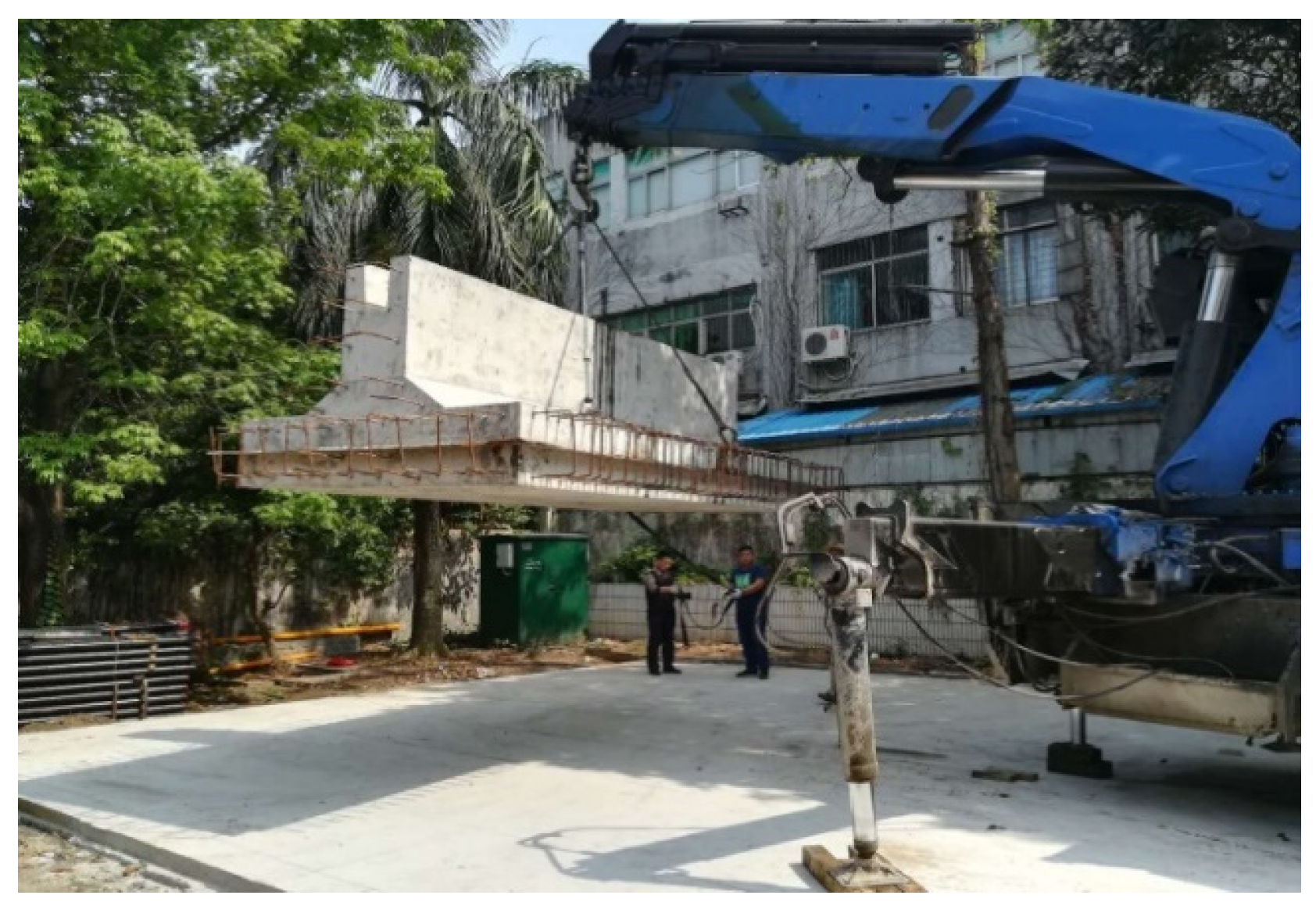
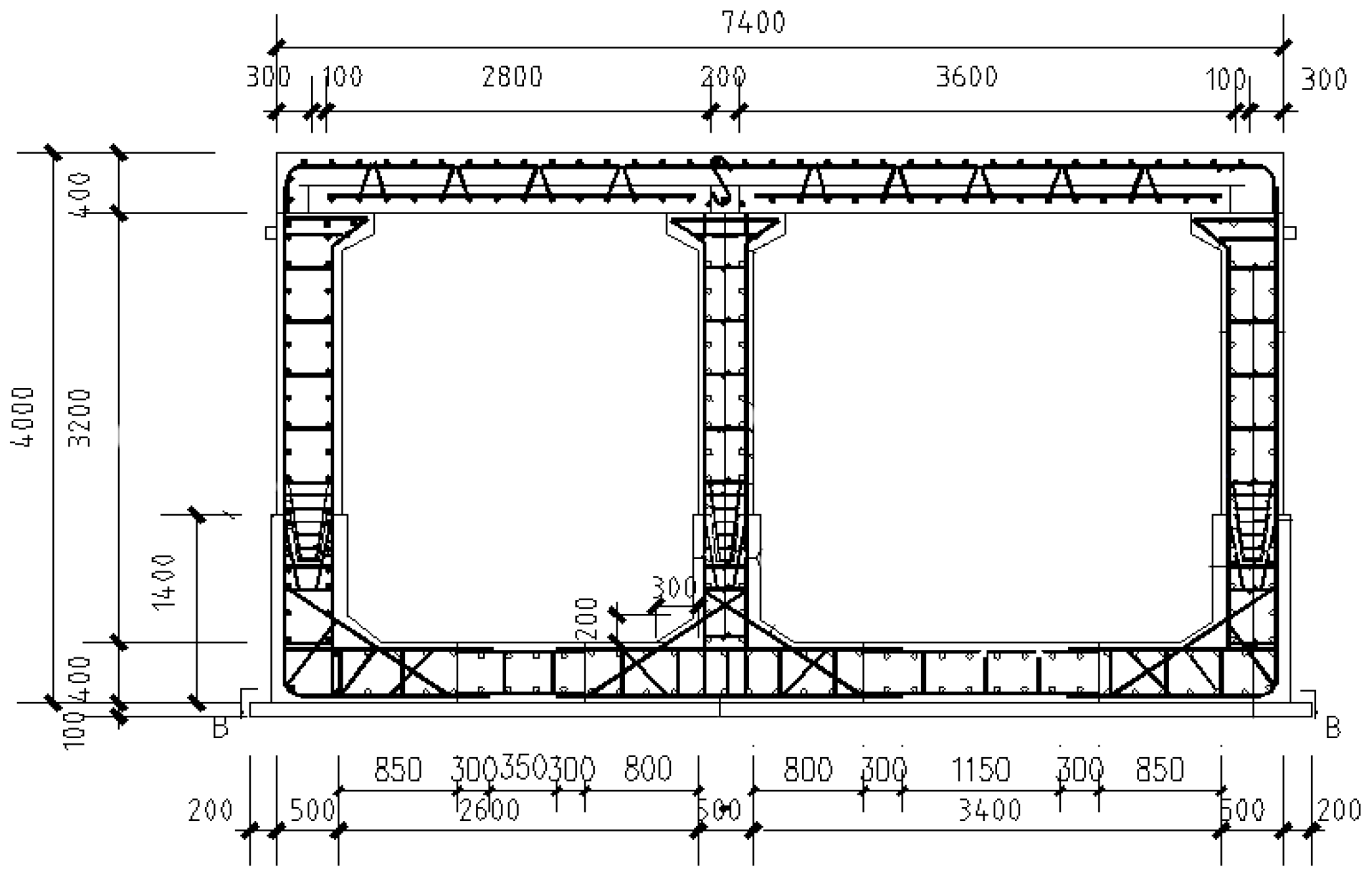
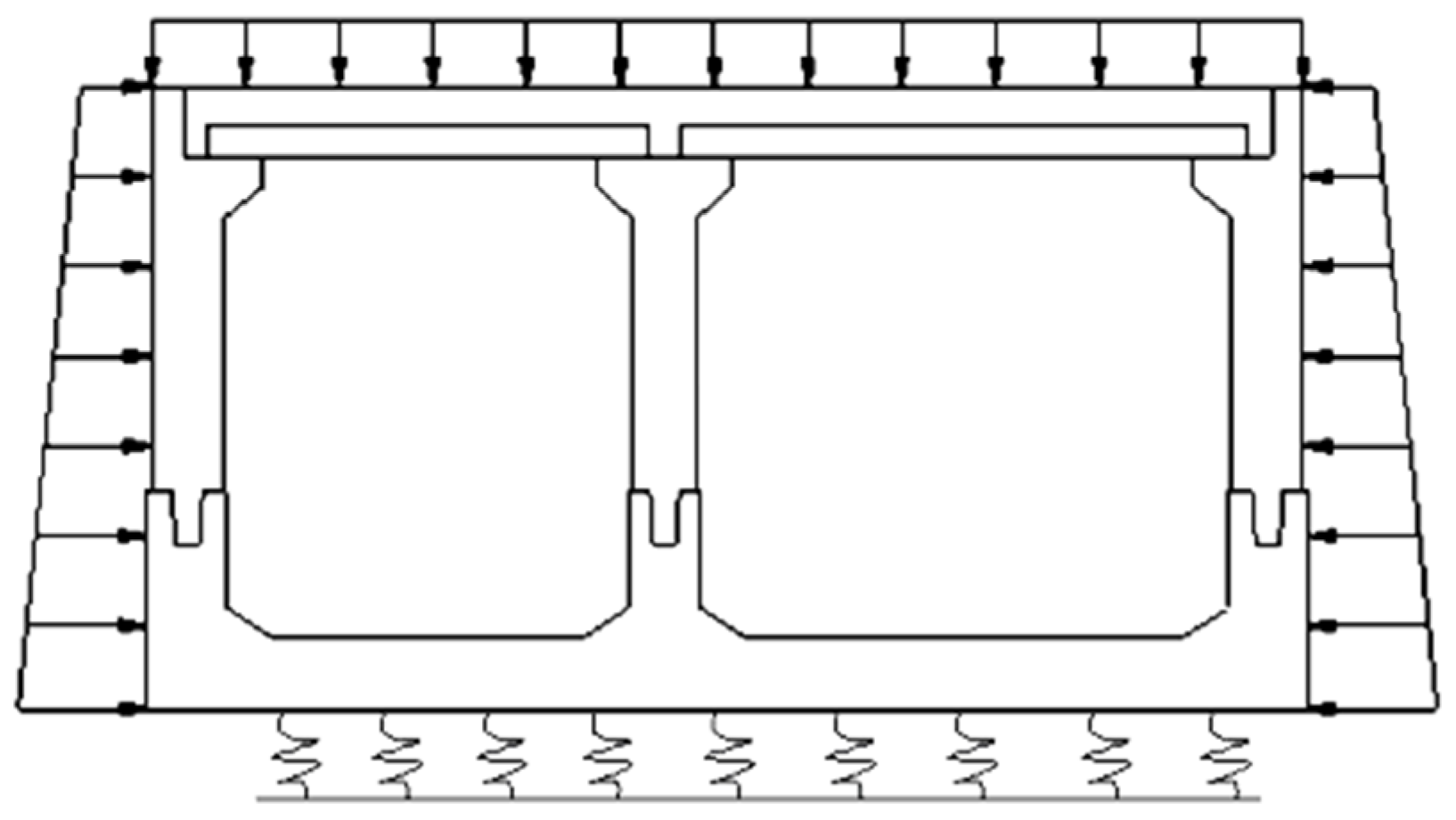
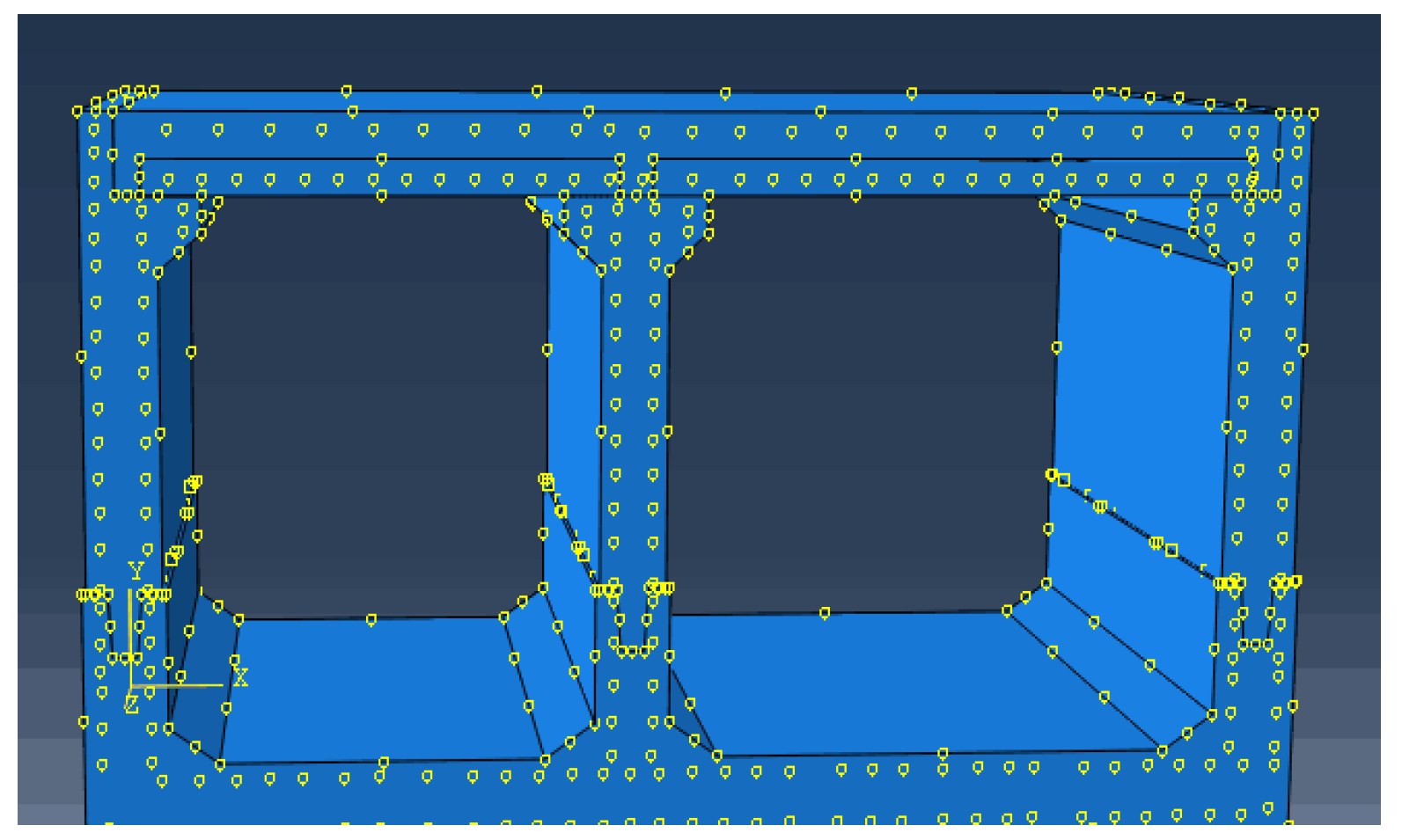
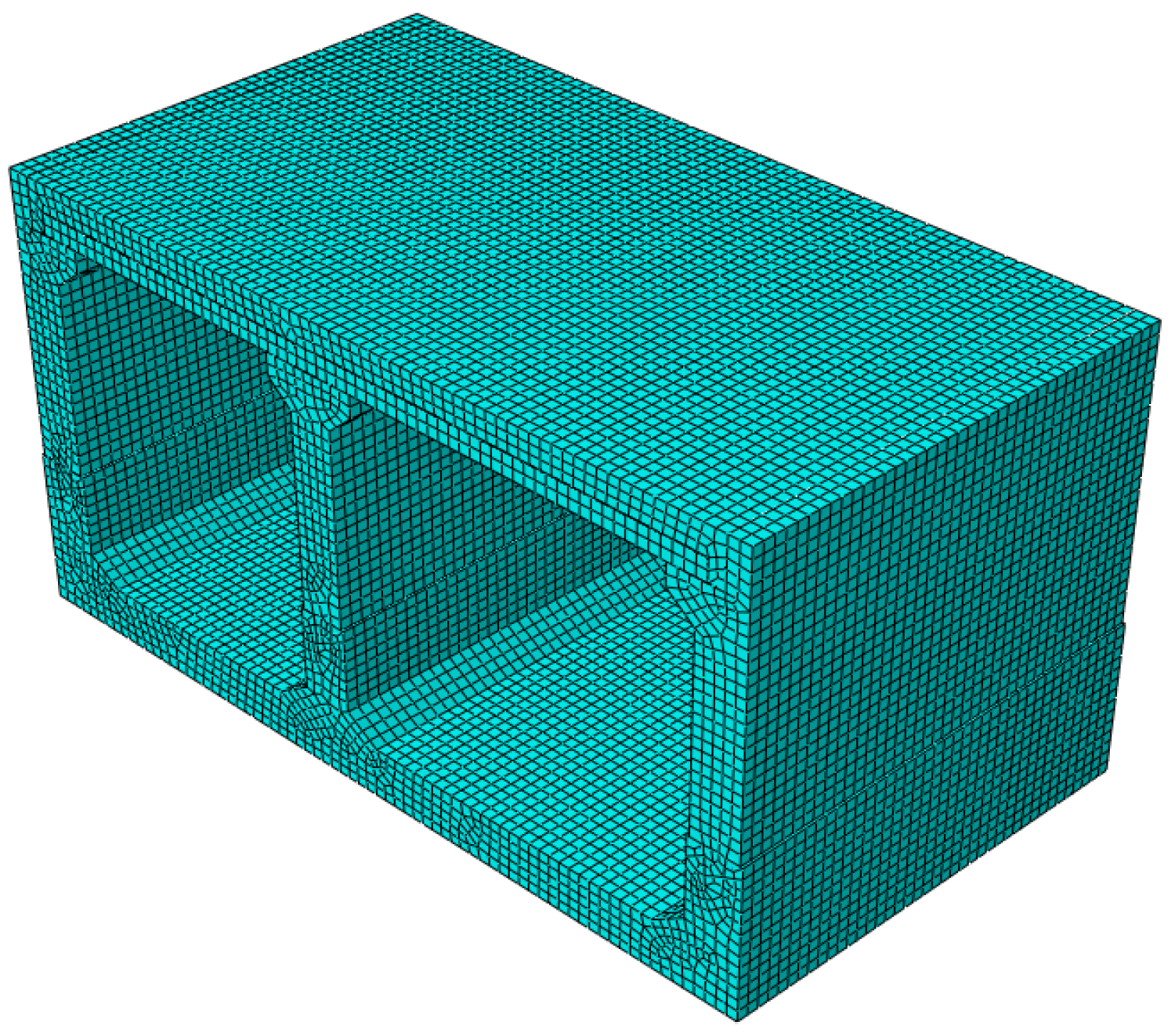


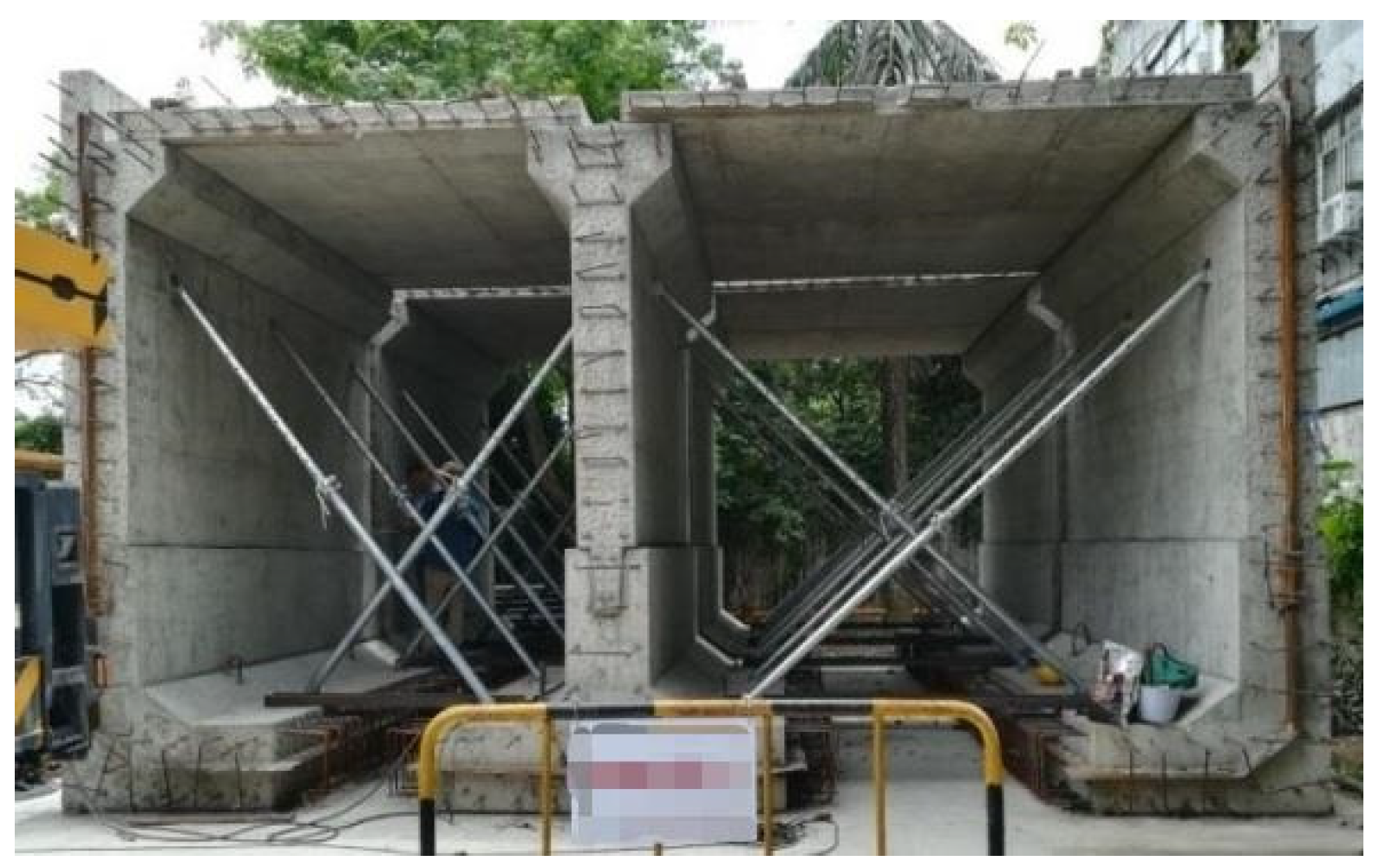
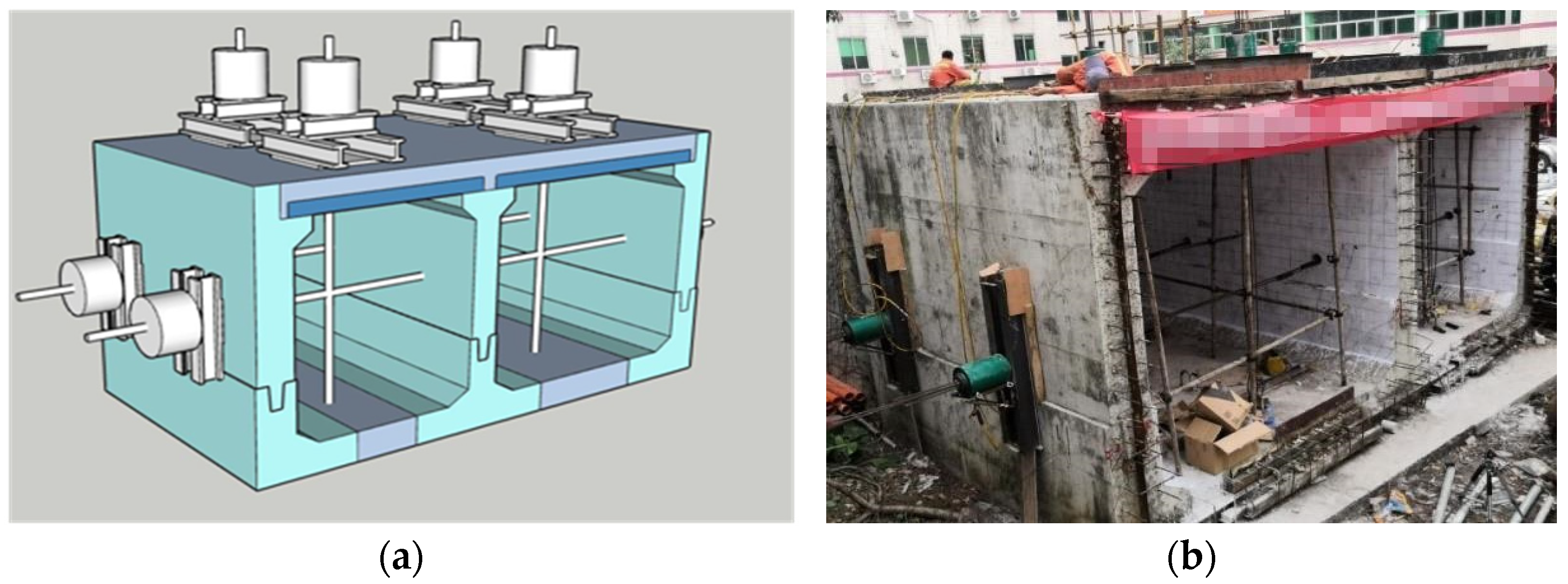


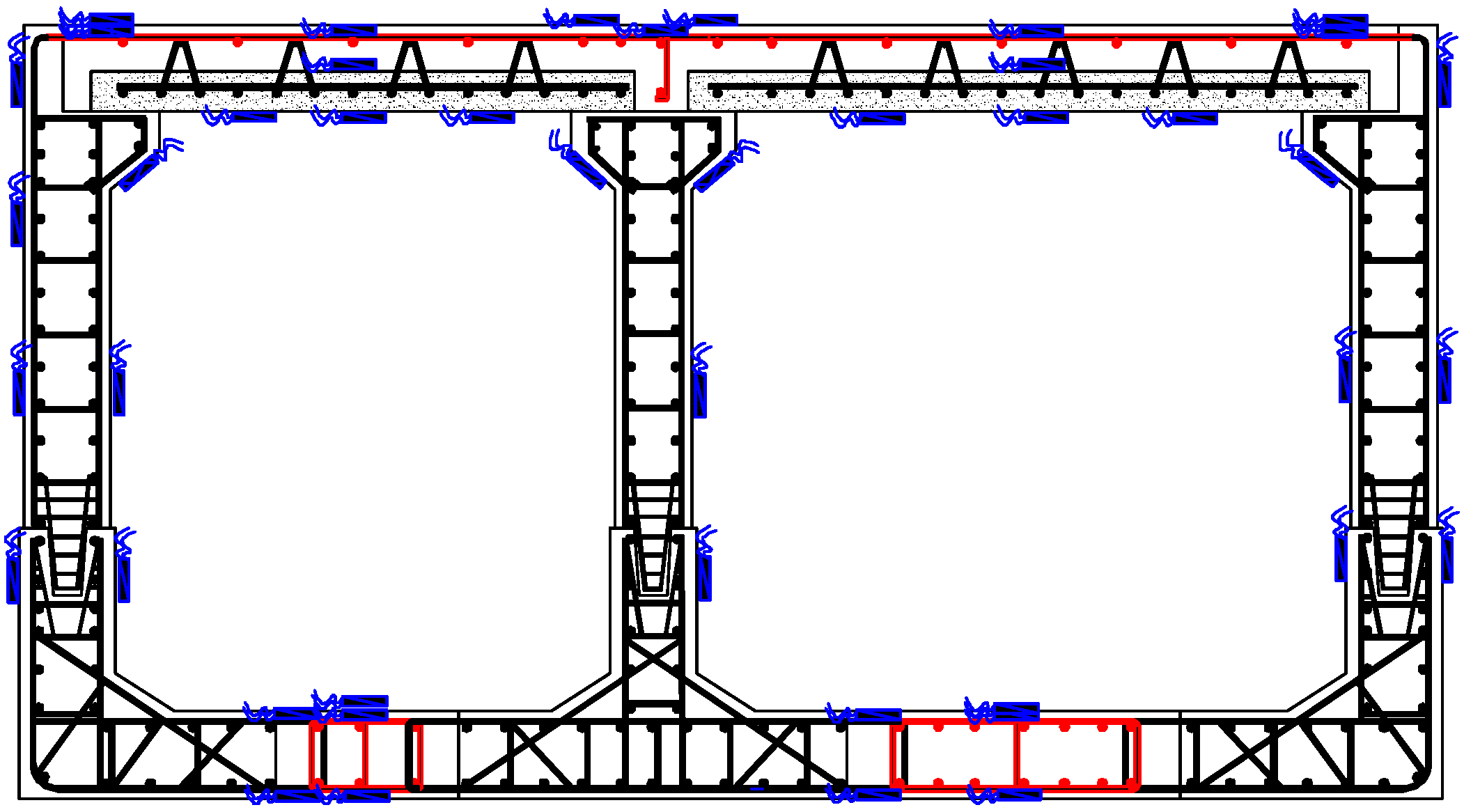
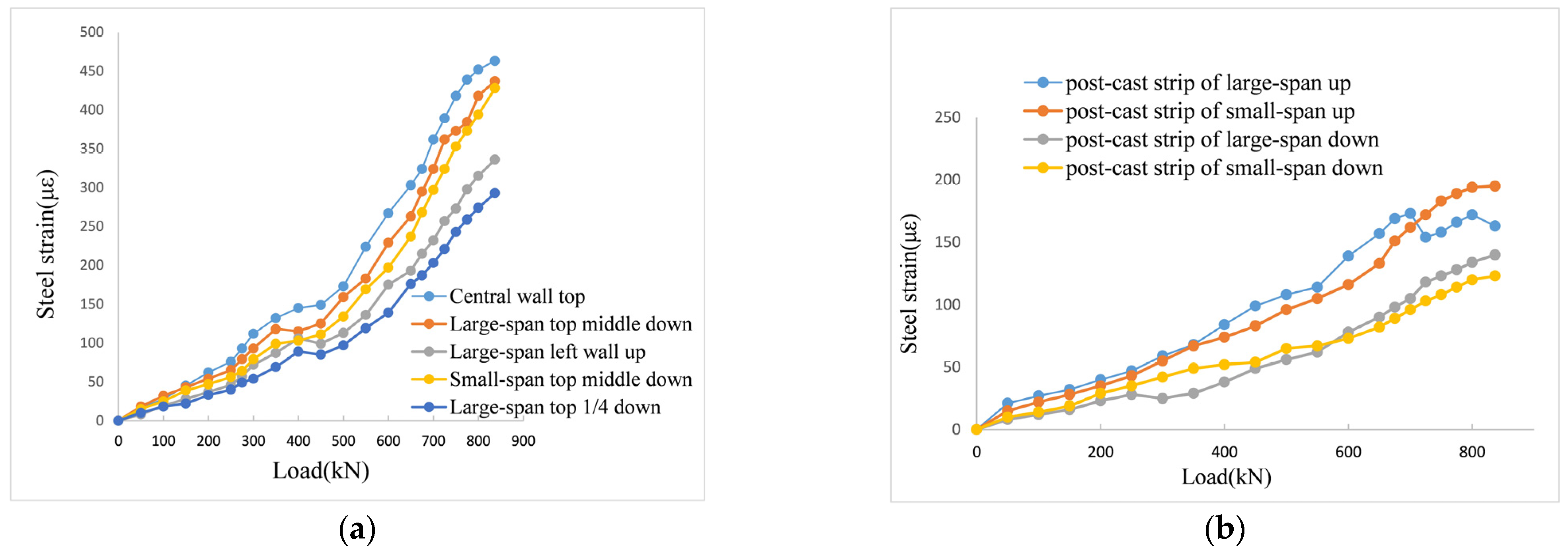
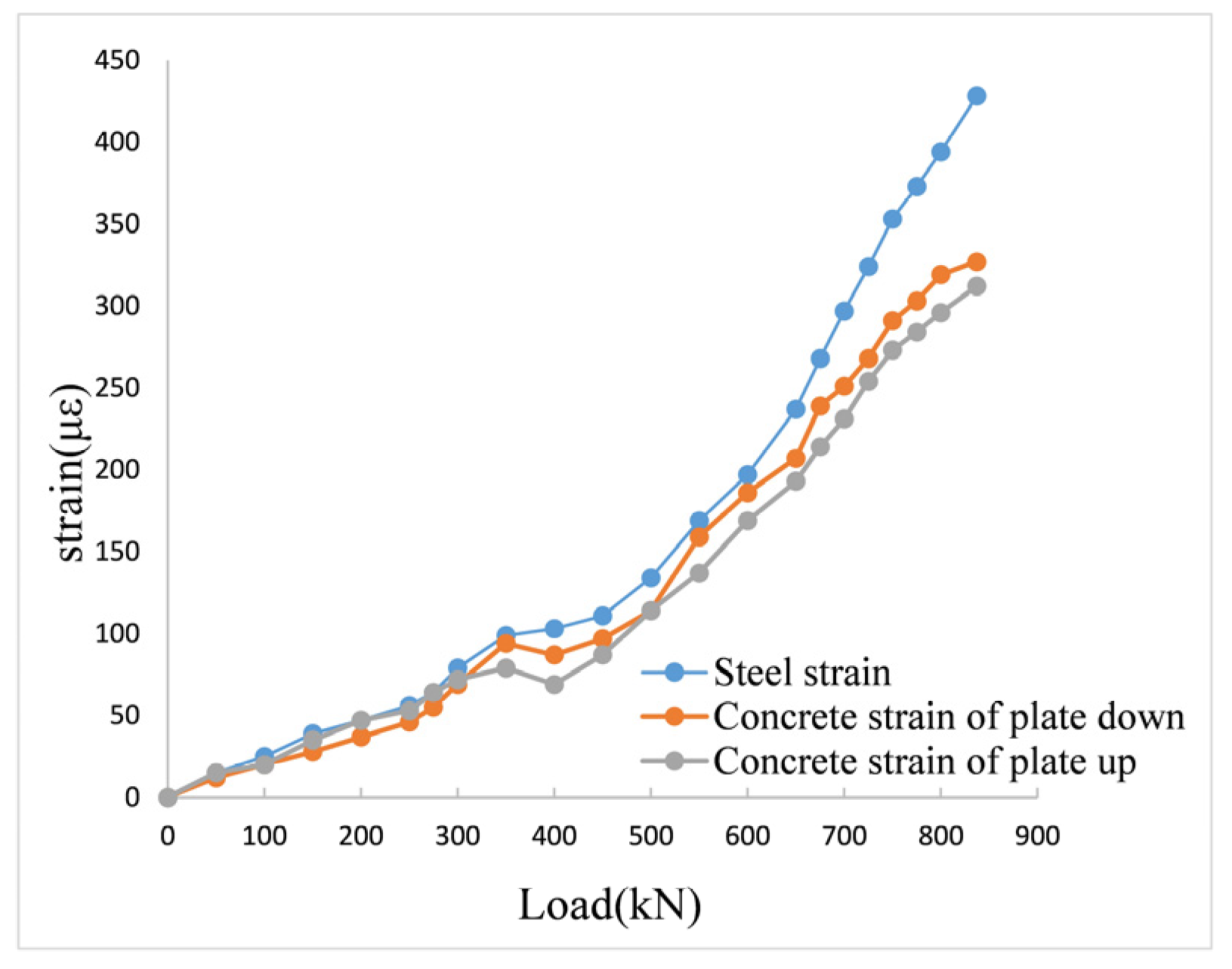

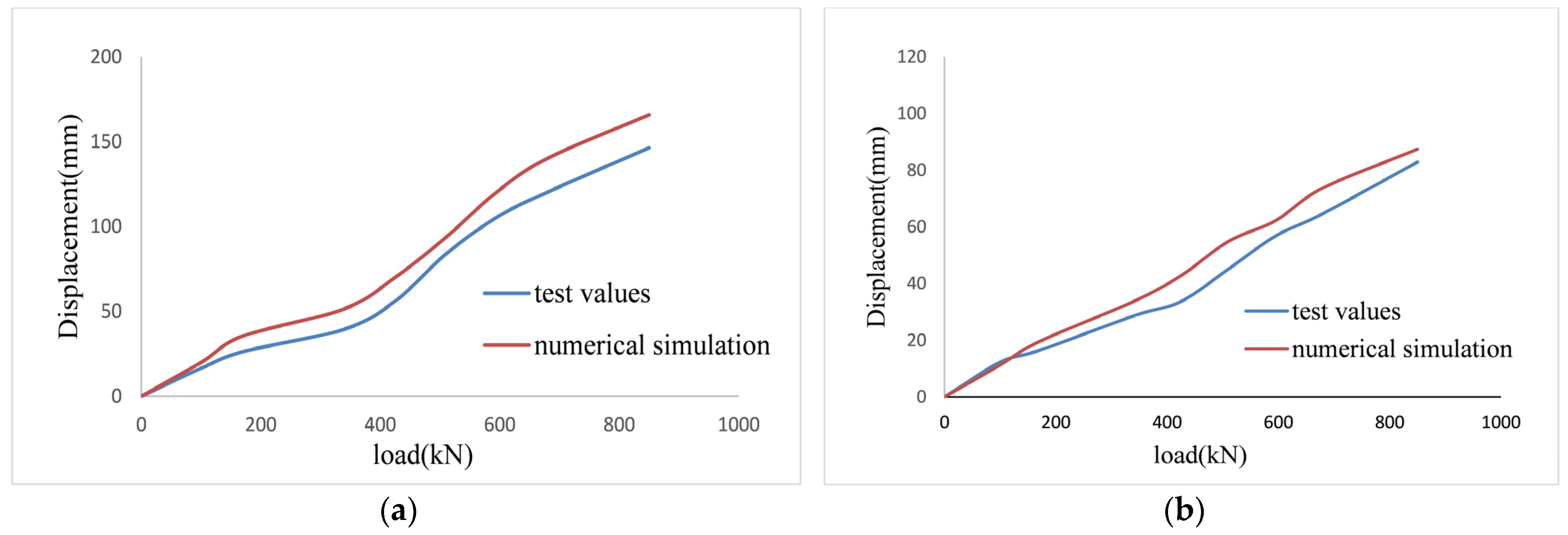
| Type | Specific Characteristics |
|---|---|
| The whole section of the full prefabricated | Adopt prestressing tendon or bolt connection, good integrity, suitable for single compartment or small cross-sectional size of the pipe corridor; high requirements for lifting accuracy, transverse splice waterproof performance and life. |
| Split components of the full prefabricated | The corridor is split into two parts, easy to transport and assemble and split, flexible, and easy to quality control; more joints, high requirements for waterproofing, and high requirements for assembly accuracy. |
| Mixed prefabricated | The “prefabricated + cast-in-place” process, representing the composite slab process, prefabricated top push process, and hollow wall slab process. It has the advantages of cast-in-place and prefabricated, simple support system, factory production quality assurance, and high production process requirements. |
| Components | PC1 | PC2 | PC3 | PC4 | PB1 | PB2 |
|---|---|---|---|---|---|---|
| Weight (t) | 11.6 | 14.2 | 11.25 | 10.8 | 4.2 | 5.4 |
| Loading Grade | Small-Span Plate (kN) | Large-Span Plate (kN) | Lateral Wall (kN) |
|---|---|---|---|
| 1 | 90 | 100 | 132 |
| 2 | 180 | 205 | 250 |
| 3 | 270 | 310 | 370 |
| 4 | 360 | 415 | 490 |
| 5 (standard value) | 468 | 523 | 580 |
| 6 | 514 | 575 | 630 |
| 7 (design value) | 561 | 611 | 680 |
| 8 | 655 | 730 | 800 |
| 9 | 750 | 835 | 920 |
| 10 | 840 | 940 | 1040 |
| 11 | 930 | 1045 | 1160 |
| 12 | 1020 | 1150 | 1250 |
| Location | Load Grade | Test Values (10−2 mm) | Numerical Simulation (10−2 mm) | Test Values/Numerical Simulation |
|---|---|---|---|---|
| Middle of Large-span | standard | 38.60 | 41.25 | 0.94 |
| design | 83.90 | 93.75 | 0.89 | |
| Final | 146.50 | 166.0 | 0.88 | |
| Middle of Small-span | standard | 30.60 | 31.74 | 0.93 |
| design | 48.50 | 60.09 | 0.80 | |
| Final | 79.90 | 87.45 | 0.91 |
Disclaimer/Publisher’s Note: The statements, opinions and data contained in all publications are solely those of the individual author(s) and contributor(s) and not of MDPI and/or the editor(s). MDPI and/or the editor(s) disclaim responsibility for any injury to people or property resulting from any ideas, methods, instructions or products referred to in the content. |
© 2023 by the authors. Licensee MDPI, Basel, Switzerland. This article is an open access article distributed under the terms and conditions of the Creative Commons Attribution (CC BY) license (https://creativecommons.org/licenses/by/4.0/).
Share and Cite
Zhang, J.; Zhang, Y.; Peng, C.; Lei, Y.; Zhang, A.; Zuo, Z.; Chen, Z. Experimental and Numerical Investigation into Full-Scale Model of New Type Assembled Integral Utility Tunnel. Buildings 2023, 13, 1428. https://doi.org/10.3390/buildings13061428
Zhang J, Zhang Y, Peng C, Lei Y, Zhang A, Zuo Z, Chen Z. Experimental and Numerical Investigation into Full-Scale Model of New Type Assembled Integral Utility Tunnel. Buildings. 2023; 13(6):1428. https://doi.org/10.3390/buildings13061428
Chicago/Turabian StyleZhang, Jichao, Yan Zhang, Chaoheng Peng, Youkun Lei, Aijun Zhang, Zhengxuan Zuo, and Zeyu Chen. 2023. "Experimental and Numerical Investigation into Full-Scale Model of New Type Assembled Integral Utility Tunnel" Buildings 13, no. 6: 1428. https://doi.org/10.3390/buildings13061428





